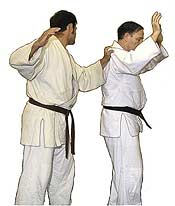Up Against The Wall # 2
By Prof. Gene Roos

Editor’ Note: When I posted the
first “Up Against The Wall” article, Gene Roos correctly
noted that the defense shown was against an attacker who pushed with
both his hands against my back trying to crowd me into a wall or other
obstacle. He suggested that a slightly different version of the defense
would be necessary if instead the attacker pushed with one hand while
holding the other up for a possible follow up strike. He was kind enough
to provide illustrations.
A common tactic for assailants is to push someone into a wall or other
obstacle with one hand and then strike from the rear with the other.
The initial push is used to off balance and control the victim.
This type of attack, however, can be easily thwarted.
In the following sequence, the attacker has grabbed my right shoulder
with his left hand and pushed me forward while raising his right hand
for a possible strike. In response I first extend both hands forward
to cushion the impact of the attacker’s push and then the right
hand moves upward to create a fulcrum around which I turn to the left
(away from the attacker’s right hand), the pivot taking me to
the back of the opponent. Here many options are possible, one of which
is shown here.
|
|
As the attacker pins the defender against a wall, his left hand
is holding the defender's right shoulder and his right hand is
going to punch the defender. |
The defender raises his right arm, which develops
a fulcrum turning position. |
|
|
As the defender's right hand is pushing
against the wall, he right foot arc steps (and rotates his body
clockwise 360 degrees). His right hand grabs the attacker's neck
and his left hand grabs the attacker's left wrist. The defender
also places his right knee behind the attacker's left knee. |
|
|
Defender's right knee h its behind the attacker's
left knee and his hands throw the attacker to the rear. |
The key points, however, are two. The first is to cushion the potential
attack and then pivot (turn away from it), which allows the attacker’s
energy to continue forward into the hole created by exiting the initial
vulnerable position.
The second key point is to ascertain from which side any follow up
attack is coming so as to pivot away from it. In this sequence I felt
a push with one hand and my peripheral awareness indicated a potential
attack coming to my right. If the attacker had been further to my rear
the hand placement of my attacker would provide a good indication from
which side a follow up attack might come. In addition, having both
arms raised in front of your face during the turn provides insurance
against any miscalculation.
About The Author:
Prof. Gene Roos, 10th dan Ju Jitsu, and 4th dan in judo, is a member
of the Board of Directors for the America Ju Jitsu Association. He is
a frequent contributor to FightingArts.com. In 1958 was awarded Shodan
(Judo) and won the Regional Judo Champion. In 1958 & 1959 was Judo
State Champion. His instructors include: Harold Brosious (Ketsugo), Dennis
Palumbo (Hakko Ryu Ju Jitsu, 8th Dan), George Kirby, & Shizuya Sato
(Ju Jitsu), Wally Jay (Small Circle Ju Jitsu), Dr. Sacharnoski (Hard
Style Ju Jitsu & Ki) and Master Mochizuki (a student of Funakoshi,
Kano, & Ueshiba). He is also the author of a series of upcoming books
on Aiki jujitsu as well as a number of videos including: "Aiki Jujitsu" (a
three video tapes series with manuals); "Deadly Attacks" (defense
against 30 knife, gun, stick and empty hand attacks); "Deadly Attacks-
part II" (defense against an additional 30 knife, gun and empty
hand attacks); "Deadly Attacks III" and "Devastating Throws
and Other Deadly Attacks " (defense against 30 advanced combat throws,
knife attacks, stick, and a rear shotgun attack), For more information
see: http://www.aikijujitsu.homestead.com/aikijujitsu.html.
|